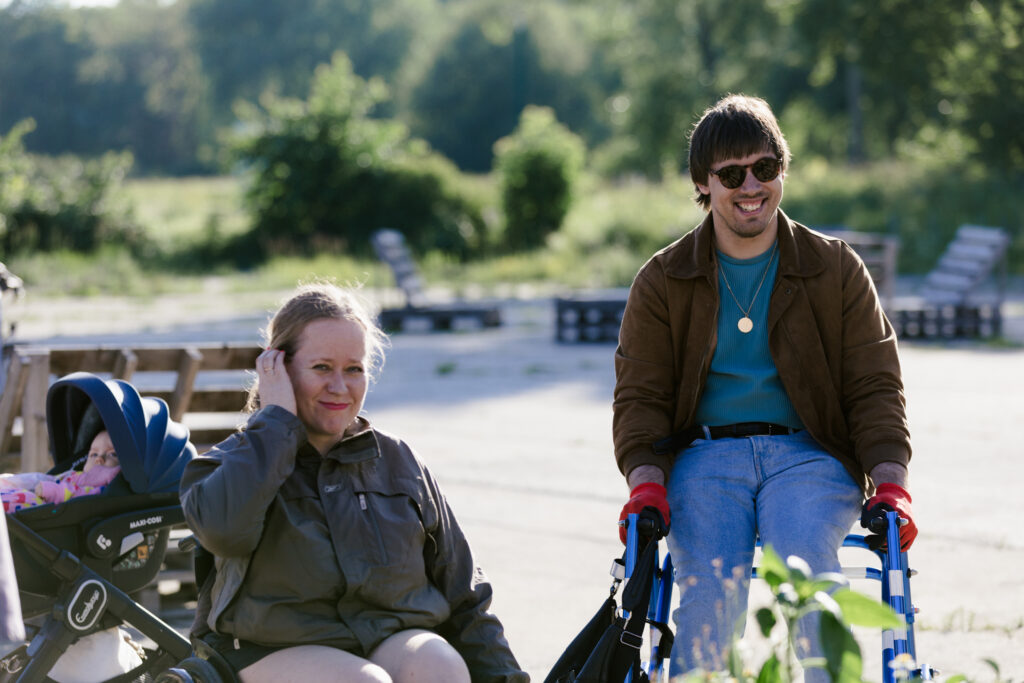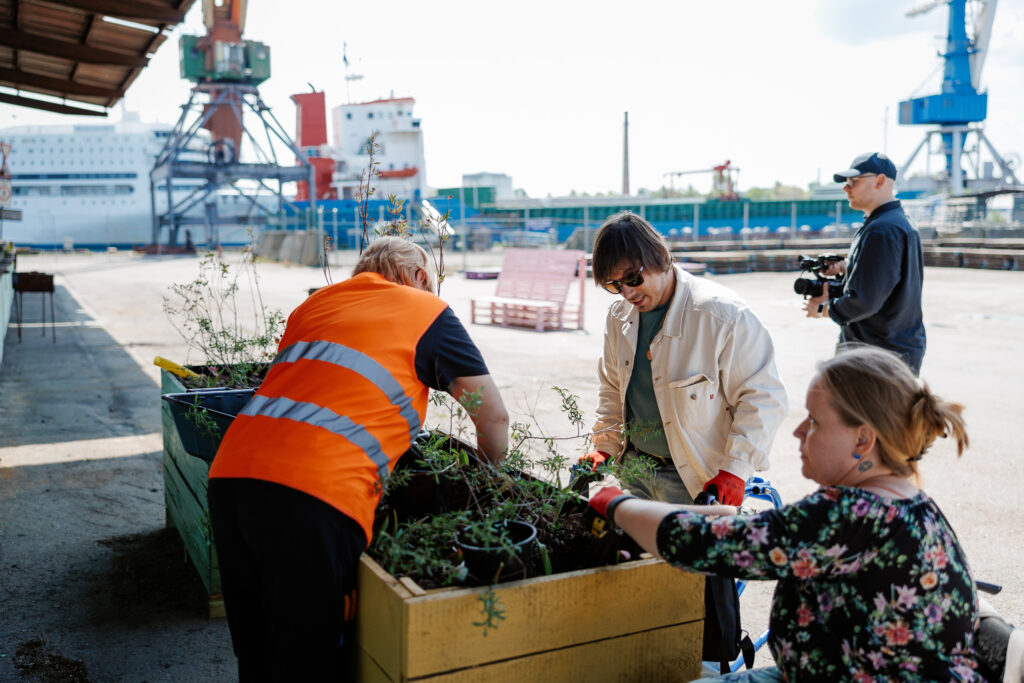At Hundipea, we’re not just building a new neighbourhood – we’re trying to understand how people actually move through and experience space. Planning well means starting from everyday life. And that includes accessibility – something that touches all of us at some point, even if we don’t always notice it. A door that’s too heavy. A step that’s just too high. A shelf you can’t quite reach. Disability doesn’t always mean using a wheelchair – it can mean a broken leg, a stroller, or simply growing older.
We sat down with Maikel Mõttus, board member of the Estonian Chamber of Disabled People and one of Hundipea’s collaborators. Maikel knows access from daily experience, and he shares his insight openly and directly.
Kerbs and regulations
Maikel has cerebral palsy. He walks with a frame, which gives him more flexibility than a wheelchair, but the same obstacles remain. “Even small kerbs can feel like the edge of a cliff,” he explains. “I have issues with depth perception and spatial awareness, so a few centimetres can feel like a huge drop.” Kerb heights are regulated by Building Regulation No. 28*, which sets the national accessibility requirements for the built environment. Things are improving, Maikel says, but it’s still common to see designs that miss the mark.
Mobility starts with access
Maikel lives in Keila, where the town’s central park is newly renovated and accessible. He gives positive examples – Tammsaare Park in Tallinn, rail travel across Estonia, and how getting to Ülemiste or further is usually simple by train. For everyday travel, he sometimes takes a taxi or rides with a friend. “Two people in a car – that’s public transport too,” he grins.
But every journey needs to be carefully planned: parking spots, access to the entrance, and enough space to get out of the car. “I can manage,” he says, “but for friends in wheelchairs, it gets much harder, especially without a designated space.”
“In our work with the Estonian Chamber of Disabled People, we talk more and more about access as a life-stage issue. It’s not just about disability – it affects you if you’ve twisted an ankle, if you’re a parent, or as you get older. It’s something that touches all of us eventually.”
Access is a daily decision
“If I have to think about whether I can use the toilet, then I have to think about whether I should even go anywhere at all.” For public events, access to a toilet can be the deciding factor. Maikel shares a recent example: “I was at Kultuurikatel for a meeting with the architects’ union. The venue was preparing for the next event, and there were things scattered on the floor that blocked my path. I didn’t want to try going over them, so I decided to head across the street to the Circle K gas station – but it turned out they didn’t just lack an accessible toilet, they didn’t have one at all. That just doesn’t make sense given the location. Silly situation.”

Where are the toilets?
“Accessible toilets aren’t just hard to find – they’re often misused,” Maikel says. Sometimes they’re locked away, with the key held by a building manager. “It’s to stop drug users,” they explain. Sometimes these toilets double as storage rooms for cleaning supplies. In one café in Jõgeva, the door couldn’t even be locked from the inside – and the space was filled with toys from the kids’ corner.
“An accessible toilet is not a storage room,” Maikel says firmly. “It’s a defined space with clear parameters. It needs to be marked and accessible.”
What could good access look like?
“I’ve told event organisers – the best experience is when no one even notices I was there. Everything just works. I get to enjoy the event and so does everyone else. And then I’ll want to come back.” He adds with a laugh, “I haven’t yet said that an event was too accessible. Until that day comes, we’ve got work to do.”
Let’s dream a little – it’s often the simplest things that make a space truly work. A bench to rest or eat. A toilet whose key isn’t hidden in a city official’s drawer. A shop shelf you can reach without asking for help.
“Rimi’s automated mini-store in Noblessner was a good surprise,” he says. “It’s small, but I fit in, and I’m pretty sure my colleagues would too. Everything worked.”
Even something as everyday as going to the movies can be a challenge. “For a while, I used to go to the cinema quite often,” says Maikel. “And I was almost always the only visibly disabled person there, probably because it’s just not easy to get in. I’ve had to crawl up the stairs on all fours because there wasn’t even a handrail.”
The job market and visibility
“There still aren’t jobs in Estonia that match the skills of disabled people with higher education,” says Maikel. “If you want something meaningful, you have to either start your own business or rely on personal connections. Look at the job listings – try the filter ‘suitable for reduced work capacity.’ The results haven’t changed since I graduated in 2017. Mostly telemarketing jobs. And even those will be taken over by AI soon.”
Still, he’s hopeful. “In our podcast Sandid Hoos, we talk to people doing big things – stand-up comedy, travelling the world, disability or not. There’s no shortage of talent or drive. We just need the chance to be part of society. Without access, we’re left out – from the economy, from everyday life.”

Access isn’t a luxury. It’s the baseline.
“In Alicante, the sidewalks were smooth like bathroom tiles – it felt nice. I want Hundipea to feel like that. Like the streets in Portugal or Spain, where you don’t get tired from just moving around.”
Maikel hopes that Hundipea will be a place where doors aren’t too heavy, benches offer places to rest, streets don’t wear you down, even low-rise buildings have lifts, and the sea is truly accessible for everyone. “Why not boat rides? Tallinn already has a sailing group for people with disabilities. I want to drive a speedboat. Hundipea could offer that – a pier where everyone can get close to the water and experience it for themselves.”
What’s Maikel’s wish for Hundipea?
“Let’s keep working together. I hope this place becomes something we can all enjoy – now and decades from now.”
What do we take from this conversation?
Maikel’s perspective is a good reminder: good public space doesn’t just happen. It doesn’t come from closed rooms or small circles. It takes listening, asking questions, and learning from people who move through the space every day. We are working to make accessibility something you can actually feel, not just something that’s written down. From kerbs and benches to lifts and toilets, the small things shape whether a space works or doesn’t.
As Maikel put it: “The best outcome is when no one notices I was even there. I get the experience, you get yours – and I’ll be back.”
Access that works without drawing attention to itself. Not a luxury, but a baseline. That’s what we’re building toward – in collaboration with Maikel and others who help us see the city through the eyes of the people using it.
* Puudega inimeste erivajadustest tulenevad nõuded ehitisele–Riigi Teataja


